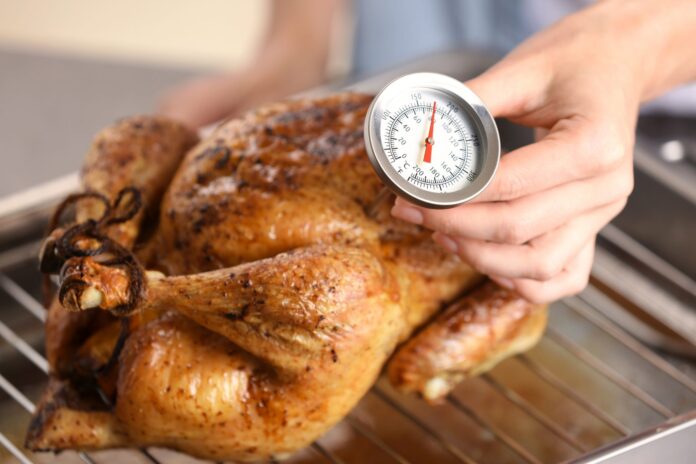AUBURN UNIVERSITY, Ala. – While Thanksgiving might look a little different this year, proper food safety measures when dealing with the turkey have not changed. From thawing to cooking, there are safety measures that must be taken throughout the entire process.
Thaw safely
Thawing a turkey takes a little bit of planning ahead. It takes approximately 24 hours for every four to five pounds to thaw.
Bridgette Brannon, an Alabama Extension food safety and quality regional agent, warns that people must beware of the temperature danger zone when thawing. This zone is between 41° and 135° F.
“In this zone, pathogens can grow very quickly,” Brannon said. “For this reason, the turkey should not be thawed at room temperature.”
Brannon said the safest way to thaw a turkey is in the refrigerator.
“Place the turkey on a pan and put it on the bottom shelf of the refrigerator,” she said. “Also, keep the bird in its packaging when thawing. This prevents cross-contamination with other items that it may come into contact with.”
If it was thawed correctly, people can keep the turkey in the refrigerator for up to two days after thawing. The USDA says that foods thawed in the refrigerator can be refrozen without cooking, but there may be some quality loss.
Cook safely
When it comes to cooking, Brannon said the turkey should not be cooked at a temperature lower than 325° F. Also, before cooking the turkey, people should remove the giblets from the cavity and cook them separately.
“When testing the temperature of the bird, check several spots to ensure that the bird is cooked evenly throughout,” Brannon said. “These spots should include the innermost part of the thigh and wing, as well as the thickest part of the breast.”
Turkey and dressing go hand in hand at many Thanksgiving meals. Instead of cooking it inside the bird’s cavity, people should cook the stuffing/dressing in a pan separate from the turkey. This is to ensure that it cooks to a temperature of 165° F.
Deep frying
Many have thrown out traditional cooking methods over the years and chose to deep fry their turkey instead. This kind of frying is done outside in a large kettle of hot oil over an open flame.
Janice Hall, also an Alabama Extension food safety and quality regional agent, said people must choose the correct location before cooking.
“It is important for people to choose a safe location for frying the turkey,” Hall said. “This type of cooking should be done in a spot away from the house and other structures. There have been many fires started from this method of cooking.”
According to the U.S. Fire Administration, people should only use a turkey fryer outdoors, on a sturdy, level surface, away from things that can burn. They suggest having a “3-foot kid and pet-free zone” around the turkey fryer to prevent injuries.
Having proper frying equipment is equally important. Hall said people should select a cooking pot that is large enough to completely submerge the turkey in 1 to 2 inches of oil without it spilling over the top.
“To determine the amount of oil needed, put the turkey in the container and fill with water,” she said. “Remove and either measure the amount of water in the pot or mark a fill line on the outside of the frying container.”
According to Hall, make sure the container is clean and dry before frying, then pour in the oil and heat to 350° F. Carefully lower the turkey into the hot oil and cook 3 to 5 minutes per pound.
“Before frying, make sure the turkey is completely thawed,” Hall said. “Partially frozen turkey will cause hot oil to splatter.”
The National Park Service website offers several tips on fire prevention and safety when frying turkeys. (www.nps.gov/articles/p52-deep-fried-turkey-fire-safety.htm)
Insta cooking
An even more popular trend recently is the idea of instant cooking. Many are surprised that even the holiday turkey can be cooked using this method.
“Cooking a turkey in an electric pressure cooker is a method many people may not have considered for the holiday season,” Hall said. “Last year, I pressure cooked a 7-pound turkey for the first time, and it came out amazingly tender and full of flavor.”
While there are many ways to pressure cook a turkey, Hall says she starts by cutting it in half and submerges it in chicken broth. She then adds celery, bell pepper, onion, poultry seasoning, garlic cloves or powder, salt and pepper.
“You can stick to whatever flavors you traditionally use to create a broth for stuffing,” she said. “I set my cooker on high for 50 minutes and then allow it to naturally release in pressure.”
More information
For more information on food safety during the holidays, visit www.aces.edu or contact the food safety and quality agent serving your area.
































